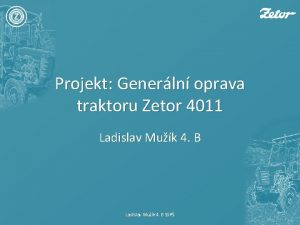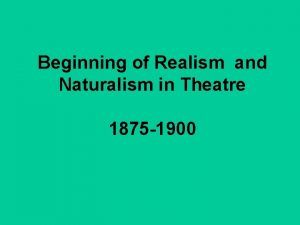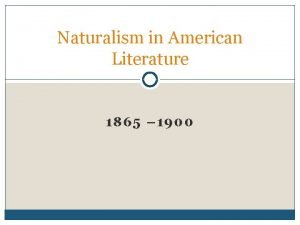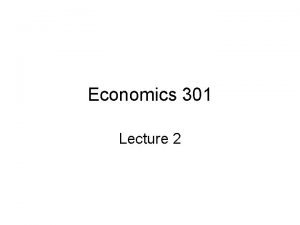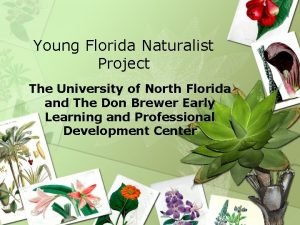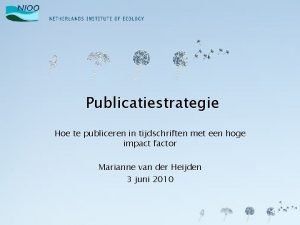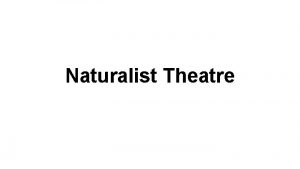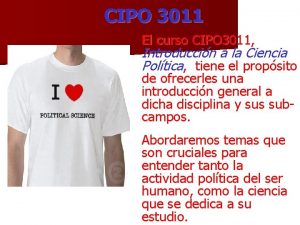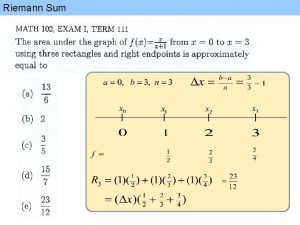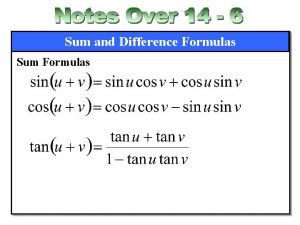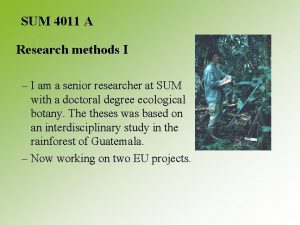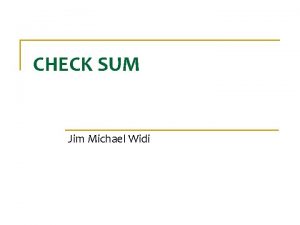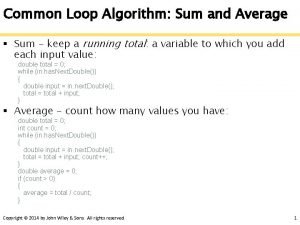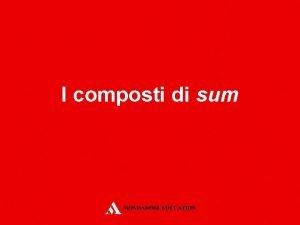SUM 3011 A 4011 A The naturalist approach

















































- Slides: 49

SUM 3011 A / 4011 A The naturalist approach and research methods 1

• I am a senior researcher at SUM with a doctoral degree in biology. • I call myself a human ecologist. Now working on: - an EU project, “LUPIS, ex-ante assessment of land use policies in developing countries”, - and a project, Climate change in Tanzania: adaptation of natural and social systems 2

Prescribed texts -Read and comprehend the object of each paper -Pay attention to different methodologies used. - Read them critically. -Don’t pay attention to the technical aspects of the statistically method. 3

Introduction to different research methods -Interdisciplinary study, and natural versus social science - Different types of research methods - Some critical aspects of sampling design - We will read a text critically 4

Disciplinarity / Interdisciplinary studies § Few large problems can be solved using one discipline only. § It is important to recognize that there are many aspects to a problem - which requires different approaches! This does not mean that all studies have to be interdisciplinary… 5

Disciplinarity / Interdisciplinary studies § Many researchers presents their results as a general truth about a situation- though the statement in fact also relates to other disciplines. . § Be aware of the competence of authors (and your own). § Is it possible for one person to be competent in more than one discipline? 6

Disciplinarity / Interdisciplinary studies, issues § Different disciplines may or may not apply different methods. § However, different disciplines apply different theories, and are likely to see the world different. § The larger epistemological difference is found between natural and social science – or between the naturalistic and the constructivist approach. § Do you remember ? What is the naturalist / constructivist approach? 7 ?

Naturalistic approach – assumes that there is a real world out there, independent of the observer, that the world is uniform and orderly, that observations and observation statements allow us to access that world. These patterns are made accessible to the naturalist by the systematic use of particular methods or techniques. The most important of these are control and comparison. The constructivist approach – For a social scientist the patterns of interest are not firmly rooted in nature, but are a product of our own making. They recognize that people may look at the same thing and perceive it differently. –A much broader set of epistemological tools are used including empathy, authority, myth, . . 8

Disciplinarily / Interdisciplinary studies – Positive aspects with interdisciplinary studies? – Negative aspects with interdisciplinary studies ? – What about multi-disciplinarily ? – Why is it difficult? 9 ?

Disciplinary / interdisciplinary study • Positive and negative aspects with interdisciplinary studies. • Typical aspects of natural-, versus social science studies? Social and /or natural science? Cooperation or not? ?

The LUPIS project LUPIS assesses the strengths and weaknesses of new policies prior to their introduction. Brazil - Data intensive models are used, often data generalised for a larger region is used. - Such a project demands an interdisciplinary apporach!!! Mali China

Different types of methods in the naturalist tradition. • Experimental method Statistical methods Observational study Survey study • Non-experimental methods Comparative method Case study method 12

v The Experimental method • The experimental methods reassures us that the relationships discovered are real and direct, and not the result of some accidental (contextual) influence. • Experiments allows us to focus on particular associations, or correlations / co-variations. • Experimentation is “experience carefully planned in advance”. 13

v Experimental method • The method involves two operations rolled into one: a demonstration that when an independent variable X is present (predictor variable), then its dependent associate Y (response variable) is present as well. • Experimental method are those which include, random sample units, manipulation of predictor variable and randomization of treatments. 14

Predictor variable : different weather conditions Response variable / study units: roses 15 Experiment: random allocation of manipulated predictor variable on response variable/ study units

v Experimental studies • The Moe et al. article: – Tests whether a poison (the treatment) could produce indirectly postitive effect on blowflies - that is produce more blowflies. – Manipulation of predictor variable: toxic treatment or no treatment – Random selection of response variable : Adults from control groups were randomly allocated to cages with either control or toxicant treatment for the second generation, and correspondingly for adults from toxicant larvae treatments 16

v The experimental method § Important, an experimental study is designed to test a particular hypothesis. - Furthermore, behind the hypothesis are theories, and most often other studies as well. § What can an experimental method do? - and what can it not do? 17

v The experimental method • There can be a number of moral and practical hindrances for experimental research. • Highly controlled studies, such as laboratory experiments, may not give rise to realistic results. – Relates to the concepts of internal and external validity • There is usually a trade-off between control and realism. 18

v Experimental studies • An example : Estimating pine seedling response to ozone and acidic rain. – Ozone level (treatment) was forced into the chambers surrounding the plants. Different levels assigned at random. Four replicates of each level. – Acidic rain levels were imposed by dispensing volumes of premixed solutions (natural rain was excluded). Different levels assigned at random. Four replicates of each level. – Each chamber can receive only one level of the ozone-acidic rain combination. – Thus the experiment involved both manipulation of predictor variable and randomization of treatments!! 19

Quasi experiments. . • Stratified random sampling (convenient sampling) - not complete random sampling. • To focus on properties of the study units. . / or to avoid sampling error. • We use theory to help control for expected variation. • “By employing quasi-experimental designs, the experimenter accepts a lesser degree of internal validity” – Examples ? ? – Do we find quasi experiments less valid? ? 20

Statistical methods A mathematical way of summarizing and interpreting quantifiable research results. Involves the systematic random collection of independent units. Uses a high ”N”. 21 Observational studies Survey study

v Statistical methods • How much can we infer about the nature of the observed relationships? - Statistic are used to provide information about an event which has already occurred. Descriptive statistics - the mean, the density, 22 frequency, dominance, age classes, demography, percentage of ethnic people in the community, etc Inferential statistics - Replicates many of the features of the experimental method, seek to generate predictions or explanations about situations.

Inferential statistics - Seeks to infer about characteristics of a population, in order to generate predictions, and explanations. • Regression allow us to predict the value of a dependent variables given the value of an independent variable. • Bi-variate regressions - how changes in the level of a single independent variable are related to changes in a dependent variable. • Multi-variate regressions allow us to expand on the number of independent variables. 23

Statistical analysis The utility of statistical analysis depends critically on: - the availability of reliable data. - in sufficient numbers. - and the each study units have to be independent. How can we fool with statistics ? ? 24

v Observational studies • Observational studies are controlled studies designed with respect to a particular hypothesis, but which lack randomisation of treatments , i. e. there are treatments but these are not randomized. • Such studies usually involve exploring relationships between a predestined set of response and predictor variables in a natural setting. • Such studies are weaker in control than experimental studies, but are usually stronger in realism and representation. • Observational studies (and surveys) often precede experimental studies. 25

The Peres et al. article uses an observational method Why? • It tries to test a hypothesis • The response variable is subject to different treatment levels; – the tree populations (the response variable); – levels of seed exploitation(treatment levels) : persistently harvested stands, unharvested, lightly harvested stands, and moderately harvested stands

v Surveys • Survey research types: encompass a wide range of studies. Descriptive enumerative studies that are not based on any particular hypotheses. • Most use descriptive statistics, some also use inferential statistics. • No manipulation of predictor variable, no hypothesis testing, but research questions. Central issue is sampling. 27

v The Nesheim et al. study - a survey • No particular hypothesis, but research questions • A field study, and the central design is sampling • Quantifiable variables, number of species used, number of species used for a particular purpose, number of people using species. Statistical method, descriptive statistics.

Repetition, some important concepts Randomization – what, when and why. . In experiments and in statistical methods when selecting sample units. In experiments when randomly allocating treatments on study units We randomize to avoid potential bias. Bias what ? It is a statistical dependency between sampling units, - in other words, the selected distribution of study units are dependent, thus the results may be wrong ie. will not likely reflect the whole study population. Replication - what and why? You replicate to increase reliability Relevant for experments. 40

v Comparative methods • Comparative studies select their cases on the dependent variable. • Cases are selected in such a way as to maximize the variance of the independent variables and to minimize the variance of the control variables. • Case selection is a strength, but it also introduces some problems. – in particular selection bias. • The comparative method relies on more than three or four, hence problems of over-determinations haunts the method.

v Comparative methods; The method of difference. • All cases share some key explanatory factors and the presence or absence of this factors can then be suited to explain any variation in outcomes. • But, it is not possible to find cases similar in all respects but one. - We do this often in everyday life. - What about in research – why can we not rely on this for defining a true causal relationship ?

v Comparative methods; The method of agreement. • The investigator collects cases of particular phenomenon in an attempt to find common factors in these cases that are otherwise quite different. • A phenomenon is then explained by the common presence of that factor. • Inability of this method to establish any necessary link between cause and effect. • The Indirect method of difference – combines the method of difference with the method of agreement.

v Comparative methods; Method of concomitant variation. • Changing the magnitude of one factor results in the change in the magnitude of another factor. • The method notes how a quantitative change in the effect is associated with quantitative changes in a given factor. • Can track variation in strength rather than in the simple presence or absence of a variable.

v The Schulze et al study - a statistical survey and a comparative method “ the method of concomitant variation” • No particular hypothesis, but research questions • The central design is sampling • Quantifiable variables, number of individuals / density, incremental rates, mortality rates. Mostly descriptive statistics. • Compares density patterns of tree species relative to logging impact in a few study plots.

v Climate change and adaptation of social and natural Co mp systems. m arat • A project in rural Tanzania, three main types of study areas: eth ive (sim discu od s dif ilaritie ses f reg erenc s) an d ion e al s on lev el - the dry central part, the more moist highlands, the costal areas. a - Questionnaire survey of 100 households in each village, focusing on various adaptation strategies. Sta tist i foc cal m ch use et nd aract s on hod on relat eristi vi lla ionsh cs ge lev ips el

Some critical issues regarding the sampling design. Important to consider when you design your own study. Important to consider when reading an article. 35

Random or subjective selection? – Objectivity demands a high number of study units/plots to ensure representativity. – Complete random sampling ensures that all units have the same probability of entering the sample. 3 Work load – Do you seek to record general or specific data? e Re s re at t n ty i v i p Objectivity

Independency between study units? ? • Lumping of plots? – How could lumping of plots have effected the results in the study by Peres et al. (the study of Brazil nut)? • Redundancy – are common types too redundant (common)? • Are rare types represented among the samples? 4

Sampling design, size and shape? 30 m • Size of plots? • Shape of plots? 330 m The size must be so that the plots are both representative, but also homogenous. Transects or quadrates? Smaller sub-quadrates within quadrates? 38 10 000 m 2 90 91 92 93 94 95 96 97 98 99 80 81 82 83 84 85 86 87 88 89 70 71 72 73 74 75 76 77 78 79 60 61 62 63 64 65 66 67 68 69 50 51 52 53 54 55 56 57 58 59 40 41 42 43 44 45 46 47 48 49 30 31 32 33 34 35 36 37 38 39 20 21 22 23 24 25 26 27 28 29 10 11 12 13 14 15 16 17 18 19 00 01 02 03 04 05 06 07 08 09 100 m 10 000 m 2

Finally…. • Qualitative and quantitative approaches work together, both may be important in a study. In what way? – Qualitative approaches are useful and necessary for in depth knowledge of a situation. – Quantitative approaches is useful for more objective comparison of different systems, and may enable statistical analysis. 39

An example, a research project “Poverty has been a major barrier to a healthy lifestyle”. The abstract • The elderly have chronic health problems attributed to obesity. • Research suggests that exercise can reduce the risk of some health problems. • The hypothesis of the study: “that older African American women living above the poverty level will practice more health promoting behaviours.

The method, including the instruments and procedure. • What were good aspects of the design? • Could there be aspects of bias in the design? • We will evaluate the results in terms of the extent to which the conclusion can be justified.

Methods & Results – How were those interviewed recruited ? – What about the tests used – are they reliable ? – Are the presented results supported by the study? – Do the results answer the purpose of the study? – Important part of interpreting the results - Do tables and figures present the results in a comprehendible way? – Are some results missing, are results confounding? – Look for speculation only!

Results, the example – Results lacking, would have been informative! • What percentage of those above poverty level had been graduated from college and high school. • A large percentage were married or widowed, but we don’t know their economic level. • Those below the poverty level had a large range of scores, along with greater variability.

Discussion / conclusion, the example • The conclusion is inappropriate! – Health-promoting behaviors were not observed. , they were reported. – we don’t know the extent to which test items accurately reflect behavior. – we don’t know the accuracy of the self-reports – Note that score might have been higher if all forms of exercise, not just recreational were reported.

Conclusion, the example • This is misleading, because it implies that exercise is a main factor that accounts for the difference in HPLP between the two groups. • Thus if groups were matched on all non-poverty level variables and were tested by a naive (with respect to the purpose of the study) individual, it would be possible to reach a valid conclusion.

Thank you for your attention! • I can be reached during office hours in my office at SUM – (second floor) if you have questions, or through email. .

Design an interdisciplinary research project • You need to introduce the project, include a statement of the problem • Study design: – Research questions /hypothesis ? , Which disciplines / which methods ? - at least use one method from the naturalist approach – – Who / what will be studied How will the informants / study units be selected? Numbers? Where ? What relationship will be examined – how will you do it (what will be surveyed, measured, interviewed which tools ? ) • Remember the time frame, is the project possible 41

Examples of possible subjects for analysis: • Desertification in the Sahel belt • The development of a national park in a biodiversity hot spot area • Pollution in a small community causing health problems • Agriculture and pesticides and herbicides • Knowledge of nature by a community • Energy consumption 42
 Zetor 4011 hmotnost
Zetor 4011 hmotnost Sum0
Sum0 Jampotfuls
Jampotfuls Economic naturalist example questions
Economic naturalist example questions History of naturalism in theatre
History of naturalism in theatre Naturalism was heavily influenced by
Naturalism was heavily influenced by Death of a naturalist seamus heaney
Death of a naturalist seamus heaney What is naturalist writing
What is naturalist writing Example of visual spatial intelligence
Example of visual spatial intelligence Maryland master naturalist
Maryland master naturalist Flax-dam
Flax-dam Economic naturalist examples
Economic naturalist examples Famous people with naturalistic intelligence
Famous people with naturalistic intelligence Texas master naturalist chapters
Texas master naturalist chapters Ohio certified volunteer naturalist
Ohio certified volunteer naturalist Interpesonal intelligence
Interpesonal intelligence Florida young naturalist
Florida young naturalist Naturalist intelligence definition
Naturalist intelligence definition American naturalist journal impact factor
American naturalist journal impact factor Approach approach conflict
Approach approach conflict Deep learning approach and surface learning approach
Deep learning approach and surface learning approach Virtual circuit tables
Virtual circuit tables Cognitive approach vs behavioral approach
Cognitive approach vs behavioral approach Theoretical models of counseling
Theoretical models of counseling Research approach definition
Research approach definition What is preliminary and fine grain screening?
What is preliminary and fine grain screening? Traditional approach to system development
Traditional approach to system development đặc điểm cơ thể của người tối cổ
đặc điểm cơ thể của người tối cổ Mật thư anh em như thể tay chân
Mật thư anh em như thể tay chân Bổ thể
Bổ thể Chụp tư thế worms-breton
Chụp tư thế worms-breton ưu thế lai là gì
ưu thế lai là gì Thẻ vin
Thẻ vin Thể thơ truyền thống
Thể thơ truyền thống Cái miệng nó xinh thế
Cái miệng nó xinh thế Các châu lục và đại dương trên thế giới
Các châu lục và đại dương trên thế giới Từ ngữ thể hiện lòng nhân hậu
Từ ngữ thể hiện lòng nhân hậu Diễn thế sinh thái là
Diễn thế sinh thái là Tư thế ngồi viết
Tư thế ngồi viết Ví dụ giọng cùng tên
Ví dụ giọng cùng tên Làm thế nào để 102-1=99
Làm thế nào để 102-1=99 Hát lên người ơi alleluia
Hát lên người ơi alleluia Hổ sinh sản vào mùa nào
Hổ sinh sản vào mùa nào đại từ thay thế
đại từ thay thế Quá trình desamine hóa có thể tạo ra
Quá trình desamine hóa có thể tạo ra Vẽ hình chiếu vuông góc của vật thể sau
Vẽ hình chiếu vuông góc của vật thể sau Công thức tiính động năng
Công thức tiính động năng Hình ảnh bộ gõ cơ thể búng tay
Hình ảnh bộ gõ cơ thể búng tay Tỉ lệ cơ thể trẻ em
Tỉ lệ cơ thể trẻ em Thế nào là mạng điện lắp đặt kiểu nổi
Thế nào là mạng điện lắp đặt kiểu nổi
